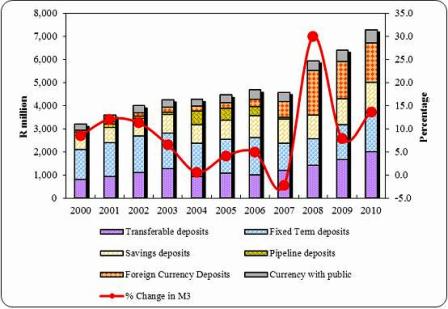Money and the money supply |09 January 2012

This can include notes and coins, as well as electronic forms of money. There are many different currencies of money such as the US dollar, the UK pound and the Euro. In Seychelles, the Seychelles rupee is used. Nearly all money systems are based on what is known as fiat money. Fiat money does not have any value as a physical commodity but has value simply because the government has declared that it must be accepted as a form of payment within the country. As such, because the government has declared the Seychelles rupee to be the domestic currency and as such has declared its value, the rupee is used as a form of payment within Seychelles. Money has been thought to have three main functions.
Firstly, it acts as a medium of exchange. This simply means that it can be exchanged for goods and services. It therefore eliminates the need for barter which proved to be inefficient. Barter is the method of exchange whereby goods and services are directly exchanged for other goods and services. This is difficult because it requires a double coincidence of wants. For example, if money did not exist and a fisherman wanted fruit, he would have had to find someone that grew fruit and also wanted to exchange it for fish. The introduction of money removes the need to find someone who has what you want and wants what you have.
Its second function is that it acts as a store of value. This means that its value should remain stable over time unlike, for example, a car which loses value over time. Thirdly, money can act as a unit of account. This means that it can be recorded that a certain amount of money exists without that money having any actual physical existence. This can be seen when payment is made by cheque. The number representing how much money is in the corresponding bank account decreases without requiring the money to be obtained in physical form for payment.
Money must also be easily portable, durable and very difficult to counterfeit (since if people could produce it themselves it would lose value). That is why notes and coins have various security features to prevent counterfeiting, and are light, long-lasting and thus easy to transport. It also needs to be divisible. If only R500 notes existed, it would be very difficult to buy small items and that is why money is divided into notes and coins of lesser value.
Money must also be in limited supply in that there is a sole supplier, which in most countries is the central bank. The money supply is the total amount of money available in an economy at a particular point in time. A country’s central bank can increase the money supply by, for example, “printing” money or by buying government bonds from the private sector. The central bank can decrease the money supply by, for example, selling government bonds or by encouraging commercial banks to hold more money deposits at the central bank. The latter can be achieved through market operations or minimum reserve requirements.
However, the central bank does not have complete control of the money supply. Commercial banks can effectively create money by giving loans thus increasing the money supply.
Loans increase the volume of deposits in the system, because not all money must be present in physical form, and by doing so increase the money supply.
Growth in the money supply, however, will generally cause inflation. This is because an increasing money supply, when the supply of goods and services remains constant usually means that people will have more money to spend on goods and services. The resulting increase in demand for goods and services will drive up prices.
There are several different measures of the money supply generally referred to by ‘M’ followed by a number, usually ranging from M0 to M3. In Seychelles we have M1, M2 and M3. M1 consists of the currency with the public and transferable deposits. M2 consists of M1 plus fixed term and savings deposits. M3 consists of M2 plus foreign currency deposits.
Furthermore, within these measures there are components of money supply – transferable deposits, fixed deposits, foreign currency deposits and so on. These components and their variation over the past 10 years can be viewed in the graph below.

Contributed by the Central Bank of Seychelles as part of its Awareness Programme




